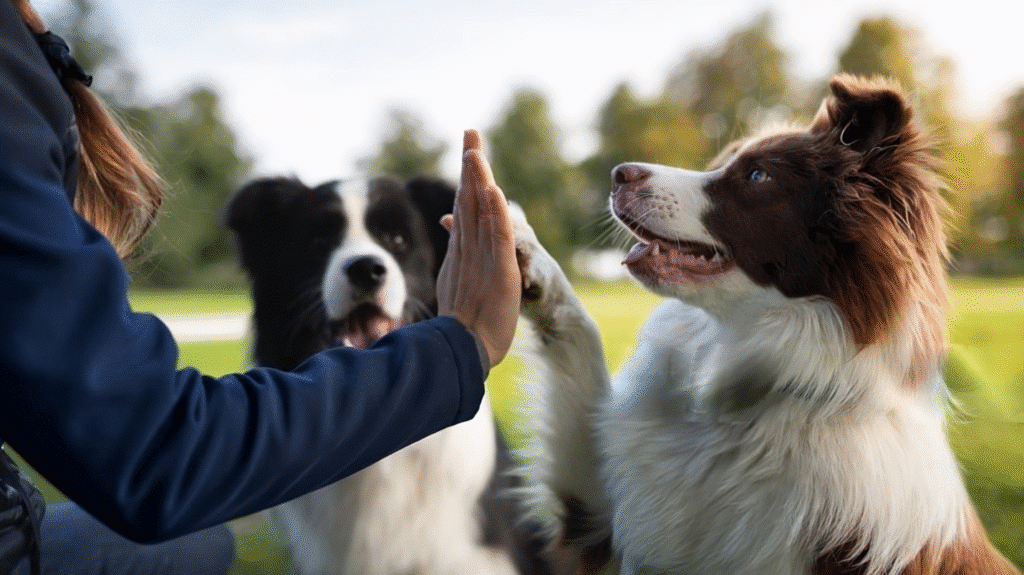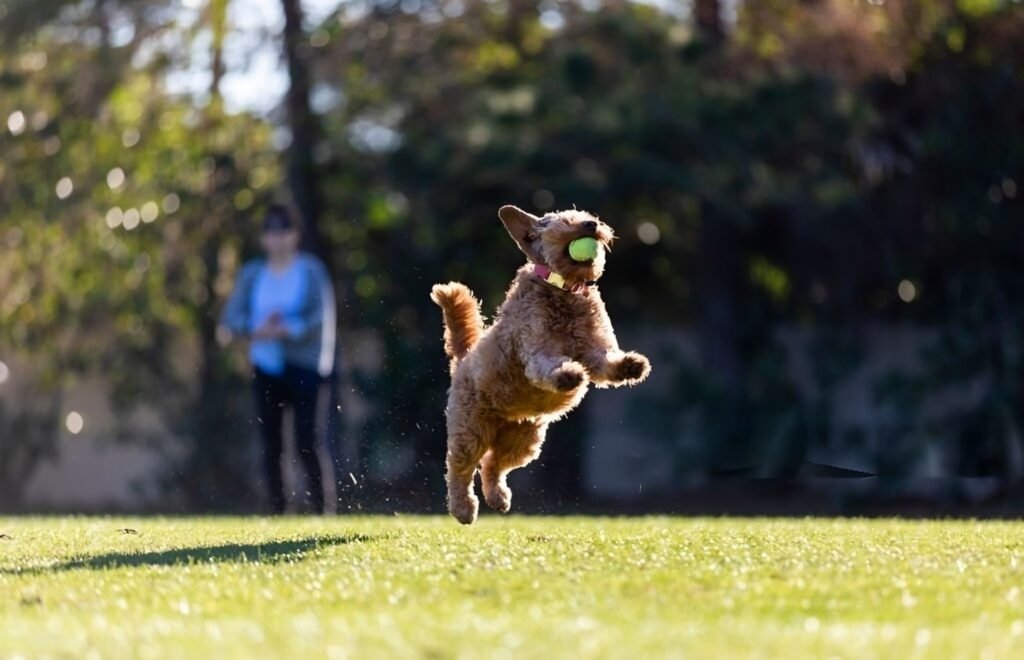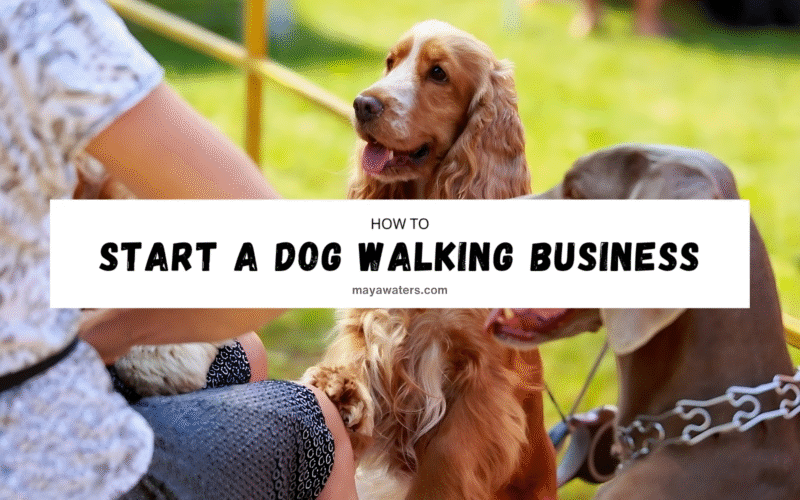This post is the ultimate guide on how to start a dog walking business — earn a FT income working PT hours!
You love dogs, fresh air, and money that does not require a headset or a cubicle. Same, girl. Same.
This is your no-fluff guide on how to start a dog walking business—from zero to booked-solid. We’ll cover the fun stuff and the real stuff: your dog walking price list, how to get clients fast, what to put on dog walking business flyers, smart dog walking business names, and a simple dog walking business logo you can make in Canva. The whole leash.
Proof this works (true story)
A few years back, I met a woman on my morning loop. She’d been a dog walker for 5+ years—Monday to Friday, weekends off—and built her schedule around school drop-off and pick-up. She called her crew “The Wolf Pack.”
One day I asked her how to start a dog walking business, as I was genuinely interested in learning how to be a dog walker.
Her routine? You won’t even believe it!
Ten dogs in the morning, ten in the afternoon. She started at 9 a.m. and wrapped by 2 p.m.—with enough time to grab groceries or sneak in a pedicure before school pickup. Back then she charged $25 a dog and took home around $10K a month. I almost fell over. Truly.
Today she charges $30 a dog and brings in about $12K a month—still working weekdays only and still running her tight route with her “Wolf Pack”. (Your rates may vary by area, but the model scales.)
Why I care (and why you should, too)
I almost launched my own pack. I did the research, priced the routes, and was one click away from a canine first-aid class—because if someone trusts you with their fur baby, you show up like a pro. Period.
Think daycare rules: we expect childcare workers to know first aid. Same energy here. If there’s a dog first-aid course you can take—do it. If not, start with vet-approved YouTube videos (free, quick, better-than-nothing) while you plan the class.
Now picture this: a client has to choose between two walkers—one with canine first aid, one without. Which one do you think that fur mama picks? Exactly. This matters when you’re learning how to start a dog walking business the right way.
I even made a checklist from the customer’s point of view—what I would want in a walker or pet sitter if it were my own pups.
I never did become a dog walker, as I had planned. Life pulled me toward this blog instead (hi!). But the plan I built? Still rock solid. And I’m handing it to you.
What you’ll learn here:
- A simple blueprint for how to start a dog walking business—without overwhelm
- A clean, copy-and-paste dog walking price list that stops the “Can you do it cheaper?” texts
- Exactly what to write on dog walking business flyers (plus a door script)
- Awesome names for dog walking business ideas and a fast logo formula
- The easy way to route walks so you work less and earn more
Grab your coffee (and a roll of poop bags). We’re about to build a simple, very profitable dog walking business—one happy wag at a time.
Is a Dog Walking Business Worth It?
YES—if you set smart routes, clear prices, and steady systems.
Pros:
🦴 You set your schedule.
🦴 You move your body (dog cardio > gym membership).
🦴 Clients are kind (and waggy).
🦴 Low start-up cost.
Cons:
🦴 Weather. (Rain gear is your friend.)
🦴 You’re self-employed: insurance + taxes.
🦴 You walk. A lot. (Good shoes, non-negotiable.)
🦴 Poop happens. We deal. Lol.
How to Start a Dog Walking Business
Step 1: Pick your model
1. Solo walks (a.k.a. “one-on-one”)
- Easy to start. No van, no big group introductions, no fancy gear. You can start on your own street with a leash and a smile. Perfect first step when you’re learning how to start a dog walking business.
- Higher rate per dog. Because it’s private time, you can charge more (think $24–$30 for 30–45 minutes). Clients pay for focus and flexibility.
- Fewer dogs per hour. The trade-off: you can’t stack as many dogs in the same time block, so your hourly ceiling is lower than group walks.
Who solo walks are great for:
- Puppies (potty breaks, short sniff walks)
- Seniors (slow strolls, meds, extra care)
- Shy/reactive dogs (safer one-on-one time)
- New clients (build trust before adding to a group)
Simple solo schedule example:
- 10:30 a.m. – Solo, 30 min ($24)
- 11:15 a.m. – Solo, 30 min ($24)
- 12:00 p.m. – Solo, 45 min ($30)
That’s a quick $78 bucks before lunch!!
When to switch to groups:
- Your route is tight (same street or two).
- Dogs know you and basic leash manners.
- You want more income per hour without adding more hours.
Start clients solo, then invite good fits into a small group. That’s the smoothest way to scale your dog walking business without chaos.
2. Group walks (a.k.a. “Pack walks”)
- More dogs per hour = more income per hour.
One 45-minute slot with 4 dogs at $22 each = $88.
Do 4 slots/day and you’re at $352/day—without adding more hours. - Same route, shared time.
You’re walking one loop, not four separate trips. Less driving. Less back-and-forth. More paid minutes, fewer wasted ones. This is the secret sauce when you’re learning how to start a dog walking business that actually scales.
- Start tiny, then grow.
Begin with 2–3 dogs. Once you’re comfy with leashes, timing, and pickups, move to 4–5 max (or whatever your city allows). Safety first.
- Screen for fit.
Energy + size + manners. New pups start solo, then join a group after a trial. Calm pack = smooth walk.
- Cluster your clients.
Aim for dogs on the same street or within a few blocks. Pickups are quick; drop-offs are faster. Your legs (and schedule) will love you.
- Cap it (and say it like a pro).
Many cities limit group size (often 4–6). Follow the rules and be clear with clients:
“I cap groups at 5 dogs so everyone gets real attention and close supervision.”
- Scale with more slots, not bigger packs.
Have demand for 12 dogs? Run three small groups back-to-back (e.g., 10:00, 11:00, 12:00). Same safety, more revenue.
Sample pack schedule (realistic):
- 10:00–10:45: 4 dogs × $22 = $88
- 11:15–12:00: 4 dogs × $22 = $88
- 12:30–1:15: 4 dogs × $22 = $88
- 1:45–2:30: 4 dogs × $22 = $88
Total: $352/day (Mon–Fr$1,760/week)
Group walks make the numbers work—more dogs per hour, more income per hour—without turning your day into chaos.
That answer is honest, safety-first, and confidence-building—and it’s exactly how to start a dog walking business that grows by reputation, not risk.
Step 2: Set your boundaries (services + area)
Boundaries make your days smooth, safe, and profitable. They also help clients trust you because they know what you do—and what you don’t. This is a core piece of how to start a dog walking business the right way.
What you do (your service menu):
- Mid-day walks (your bread and butter)
- Puppy visits (potty break + short sniff + quick cuddle)
- Basic leash manners (sit at doors, no pulling, calm crossings)
- Small group walks (2–5 dogs, matched by energy)
- Senior strolls (slow, grassy, gentle)
- Photo update after every visit (one line + one pic)
What you don’t (your safety rules):
- No off-leash in busy parks or near roads
- No aggressive dogs or unsafe behavior
- No 10-mile drives across town for one walk
- No giant packs (follow your city’s cap—often 4–6)
- No and risk (heat index, lightning, ice)
TIP: When you say “no,” offer a “yes.” Example: “I don’t do off-leash at the park, but I do long-line sniff walks in quiet areas. Pups love it.”
Draw a Simple Service Map (and stay inside it)
Keep your walking radius small at first. It saves time, gas, and stress—and lets you stack more dogs in fewer hours.
How to make your map (10 minutes):
- Open Google Maps and drop a pin on your home or “home base” street.
- Draw a radius (start with 1–2 miles or 3–4 close neighborhoods).
- Mark pick-up windows (e.g., 11–1
- List streets you serve on your website and flyers.
- Add a simple note: “Outside this area? Waitlist or travel fee available.”
Sample service area blurb (copy/paste):
“I serve Oakwood, Maple Heights, and Brookside. Outside these? Join my waitlist or add a $5 travel fee if I’m already nearby that day.”
Hours, Windows, and Weather (keep it clear)
Hours:
- Mon–Fri, 10 a.m.–2 p.m. (set your own)
- Weekend slots are limited and cost more (+$8).
Pick-up windows:
- Oakwood: 11–12
- Maple Heights: 12–1
- Brookside: 1–2
(Clients love knowing “when” instead of texting “ETA?” daily.)
Weather plan:
- Hot/icy? Switch to short walk + enrichment (sniff games, puzzle, training reps).
- Rainy? Towel-dry add-on (+$5) and a cute photo.
- Storming? Safety first. Reschedule or indoor enrichment with a quick potty break.
Scripts that make “no” sound like “I’ve got you”
Out of area:
“Thanks for reaching out! I’m focused on Oakwood/Maple Heights this month so your walks run on time. I can add you to my waitlist or offer a $5 travel fee if I’m nearby on [days]. What works best?”
Off-leash request:
“I keep everyone on-leash near roads for safety. But I do long-line sniff walks in quiet spots—dogs love the freedom. Want me to try that this week?”
Too many dogs:
“I cap groups at 5 dogs so each pup gets real attention and close supervision. I can start a second group right after yours if you’d like a spot.”
Why boundaries help your income (and sanity)
- Tighter routes = more dogs per hour (hello, group walks).
- Clear services = fewer one-off requests that break your day.
- Reliable windows = less texting, more walking.
- Safety rules = fewer incidents and pages
Quick checklist: Boundaries, locked
✅ Service menu posted (what you do)
✅ Safety list posted (what you don’t)
✅ Service map with pick-up windows
✅ Weather policy (heat/rain/ice)
✅ “No, but…” scripts ready
✅ Travel fee or waitlist set up
Set these now, and your dog walking business runs smoother from day one. Boundaries aren’t mean—they’re the secret to happy clients, calm days, and steady cash.

Step 3: Build a clean dog walking price list
Your dog walking price list is more than just numbers—it’s how you show clients you’re reliable, consistent, and worth the rate you charge. Messy, unclear prices = endless “How much do you charge?” texts. A clean, posted list = less haggling, more bookings.
Start with a few simple tiers. Think of them like a restaurant menu: easy to skim, clear on what you get, no mystery add-ons.
Example Dog Walking Price List
- 20-Minute Potty Break (solo): $15–$18
Perfect for puppies, seniors, or dogs who just need a quick bathroom trip and some fresh air.
- 30-Minute Walk (solo): $20–$25
For pups who need one-on-one attention. Great for shy, reactive, or special-needs dogs.
- 30-Minute Walk (group): $15–$20 per dog
Two or more friendly dogs, walked together. Lower per-dog cost for clients, more efficient for you.
- 45-Minute Group Walk: $22–$28 per dog
Your bread-and-butter option. More exercise, more sniffing, more happy tired pups when their humans come home.
- 60-Minute Adventure Walk: $30–$35 per dog
Optional upgrade for high-energy pups who need more than a lap around the block.
(Note: rates vary by city—urban walkers often charge more. Always check what other local walkers charge, then price yourself fairly but confidently. Undervaluing your time is the fastest way to burn out.)
Why Clean Pricing Works
- Clients respect it. If you look organized, they treat you like a professional, not a side gig.
- No awkward bartering. Your posted rates are your rates. End of story.
- Easier to upsell. Once clients see a clear structure, they’re more likely to “upgrade” to longer walks or group sessions.
Optional Add-Ons
🦴 Extra dog in same household: +$5–$10
🦴 Weekend walks: +$8
🦴 Holidays: +$15
🦴 Rainy day towel dry: +$5
Client’s love having clear extras they can choose from—think of it as your “menu specials.”
Quick Tips for Your Price List
- Post your dog walking price list on your website, flyers, and even in your email signature.
- Use round numbers ($25, not $24.37). Easy to remember, easy to pay.
- Update once a year. Costs rise—your rates should too.
A clean, easy-to-read price list is one of the fastest ways to show you’re serious about learning how to start a dog walking business that actually pays.
Step 4: Paperwork That Protects You
Listen, walking dogs isn’t just about leashes and squeaky toys—you need paperwork that has your back when things get messy.
✅ Services agreement
Write down exactly what you offer and what you don’t. Does your walk include feeding? Medication? Weekend coverage? Spell it out. A clear agreement keeps “scope creep” (aka, people asking for freebies) from eating into your time and profit.
✅ Liability insurance
Think of this as your pricey mistake shield. If a dog slips a leash, nips another pup, or pulls you into a rosebush, you don’t want to pay out of pocket. Pet business insurance usually runs $20–$40/month and is worth every cent.
✅ Pet first aid/CPR certification
With pets, accidents happen—paws cut on ice, overheating in summer, sudden illness. A certification shows clients you’re serious. (And even if you never use it, it’s peace of mind in your pocket.) If a course isn’t an option yet, at least brush up with free online resources until you can invest in the real deal.
✅ LLC once your income grows
Not glamorous, but an LLC (Limited Liability Company) separates your personal money from your business money. Translation? If something goes wrong, they can’t come for your house or your car. When you’re pulling in steady income, talk to a pro about setting one up. I’m not your lawyer—I’m just your dog-loving friend reminding you that paperwork = freedom.
Step 5: Get Clients Fast – Offline
✅ Flyer a single street at a time
Dog walking business flyers are old-school magic. Print 50, pick one block, and saturate it. People trust “the walker who walks this street,” not the random ad miles away.
✅ Knock (nicely) and pitch
Take a deep breath, smile, and say: “Hi! I walk dogs on this block every day at noon—want me to add yours to the pack?” That kind of confidence lands clients way faster than a vague “I’m a dog walker.”
✅ Make it easy to book
Don’t hand out flyers with just a phone number. Add a QR code that links to your booking page, calendar, or even a simple Google Form. The fewer steps between “I’m interested” and “I booked,” the faster your schedule fills.
If you want higher-paying clients, target neighborhoods with plenty of two-car garages and soccer-mom SUVs parked outside. These are the families who treat pets like kids—and they’re the ones happy to pay top dollar for great care.
Together, Steps 4 and 5 make you look like an absolute pro with receipts!
The paperwork earns trust, and the offline hustle fills your schedule before you even start worrying about websites or Instagram reels.
Step 6: Get Clients Steady – Online
Offline fills your schedule first. Online keeps it steady. Once you’ve got your first few furry clients, add these digital moves:
✅ Google Business Profile (free, massive reach).
When someone types “dog walker near me,” you want to show up. Add photos, hours, and reviews—it’s like free advertising on autopilot.
✅ A one-page website.
No need to overcomplicate this. Canva, WordPress, or Hostinger templates are all you need. Add your name, services, prices, and contact info. Keep it clean, not corporate.
✅ Dog walking business name + logo
Pick something catchy (see list below). Then design a simple dog walking business logo in Canva. High contrast, easy to read, and something that looks good shrunk down on a flyer or scaled up on social.
✅ Social proof matters.
Start with a simple Instagram or Facebook page where you post pup pics (with permission). Parents love seeing their fur babies happy, and those posts double as mini ads.
Online doesn’t replace pounding the pavement—but it does make sure your business keeps flowing month after month.
Step 7: Name + Logo
You want to keep your name simple but memorable if possible.
Names for Dog Walking Business
Here are 50 ideas for dog walking business names for you to use!
Sweet & Simple
Short, clear, easy-to-remember names that give a professional vibe.
- Happy Paws
- Block Walks
- Tail Time
- City Sniffs
- Paws & Pace
- Walkie Co.
- Daily Paw Patrol
- Sidewalk Snouts
- Four Paws Forward
- Morning Strolls
Cute & Punny
Playful names that stand out and make people smile.
- Leash the Day
- Bark & Stroll
- Paws on the Clock
- Woof & Wander
- Strut Your Mutt (check trademarks)
- Poop Bye
- Wagging Rights
- The Bark Side
- Sit Happens
- Walk This Wag
Place-Based (SEO Boost Online)
Adding your town/neighborhood makes it easy for locals to find you in Google search.
- [Your Town] Dog Walks
- [Neighborhood] Pack Walks
- [Your Town] Paws & Play
- [Street Name] Leash Club
- [City] Tail Blazers
- [Town] Happy Hounds
- [Neighborhood] Bark Patrol
- [Town] Canine Crew
- [City] Dog Squad
- Local Leash Co.
Premium Vibe
Names that feel high-end, professional, and trustworthy (great for higher pricing).
- The Gentle Leash
- Gold Leash Walks
- Noble Paw Co.
- Urban Canine Collective
- Prestige Paws
- Luxe Leash Co.
- Royal Walks
- Velvet Paw Co.
- Elite Pack Walks
- Noble Tails
Fun & Trendy
Modern, catchy names that work well on social media.
- Pup Culture
- Pack & Chill
- Sniff Squad
- Doggo Dash
- Wags on Demand
- The Pawcast
- Zoomies Co.
- Fetch & Go
- Bark Boss
- Pawgram Walks
Dog Walker Business Name Tips:
- Before you settle on a name, check if the domain name and Instagram handle are available.
- Keep it short, easy to spell, and memorable.
- For SEO, include “dog walking” somewhere in your Instagram bio and website header—even if it’s not in the business name.
Dog Walking Business Logo
Canva + bold font + a paw/leash icon you can see from 10 feet away.
- High contrast (black/white or dark/bright)
- Readable at business-card size
- One icon (paw, leash, heart)
- Horizontal and square versions
- Save as PNG + SVG
Put your dog walking business logo on your flyers, website, and report cards.
Step 8: Route Like a Pro
Walking dogs isn’t just about the leash—it’s about the logistics. A pro route = more money, less chaos.
🐾 Stack walks back-to-back.
Book clients on the same block or neighborhood. That way, drop-offs and pick-ups are efficient, and you’re not burning gas zig-zagging across town.
🐾 Use simple systems.
Even a basic spreadsheet can track routes, client addresses, keys, and payments. Later, upgrade to pet business apps like Time to Pet or Scout if you grow big.
🐾 Result
A quick photo + one-line text after each walk (“Rex chased squirrels, but came back proud!”) makes clients stick like glue.
🐾 Offer weekly “Pup Report Cards.”
One simple recap email or PDF: highlights, funny quirks, maybe a milestone (“Bella finally mastered sitting at stoplights!”). This tiny touch screams professionalism and makes you unforgettable.
🐾 Backup gear saves disasters.
Always carry a slip lead, water, a small towel, and some extra treats. One forgotten leash or muddy puddle can throw off your day—unless you’re ready.
Together, Steps 6 and 8 take you from “newbie with a flyer” to “trusted pro who runs their business-like clockwork.” Clients notice the difference—and so will your bank account.
Step 9: The “Grown-up Stuff”
Safety, Insurance, and LLC
Listen, this isn’t the glamorous side of learning how to start a dog walking business, but it’s the part that keeps you safe, legal, and actually profitable. Skip this, and one bad week (angry client, vet bill, IRS letter) could undo months of hard work.
Non-Negotiables
✅ Liability insurance – the minute you take paying clients, you need this. Protects you if something goes wrong.
✅ Pet first aid/CPR course – because dogs are family, and clients will love knowing you’re trained.
✅ Clear service policies – spell out how you handle cancellations, bad weather, meds, and emergencies. Saves you from awkward texts later.
✅ LLC (as income grows) – not day one, but eventually. Limits personal risk. Talk to a pro for local rules.
Red flags you can (and should) say no to dog-aggression issues, missing vaccines, or owners without a safe yard/entry plan. Protect your business and your sanity.
Money + Systems
✅ Separate business bank account – even if you’re still a sole prop, keep business $$ out of your personal checking.
✅ Track miles + expenses – use a free app or a simple spreadsheet. Gas and supplies add up—and they’re tax write-offs.
✅ Weekly invoicing rhythm – send invoices every Friday, due Monday. Clients like structure, and you like getting paid on time.
✅ Save a chunk for taxes – don’t wait until April. Skim a % off each payment into a separate savings account. Future-you will thank you.
Step 10: Raise Your Rates
Let’s talk money, and I know this is the awkward part I get it. But if you’re learning how to start a dog walking business, you also need to learn how to grow it. You see eventually, those $25 walks won’t cut it anymore—you’ll want (and deserve) to raise your rates.
Here’s how to do it without feeling like you’re breaking up with your clients:
✅New clients = new rate.
The easiest upgrade ever. Any fresh inquiries get your updated price list right away—no explanations required.
✅Existing clients = 30-day heads up.
Send a friendly message like: “Starting next month, my rates will be increasing by $3 per walk. This helps cover rising costs while I continue giving your pup the same love, attention, and care they deserve.” Most pet parents will nod and keep booking.
✅Add value while you raise.
Don’t just raise—sweeten. GPS walk screenshots, towel-drying after rainy days, or sending a “Pup Report Card” once a week make the bump feel worth it. Clients see extras, not just expenses.
First, if you want to do this the non-awkward way – never, and I mean neverrrr apologize for raising your rates.
You’re providing a professional service. If someone balks at paying $25 instead of $22, that’s a sign they’re not your long-term client anyway. The right ones will happily stick around.

Dog Walking Business Ideas That Make You Stand Out
- Block Walks: same street, same time. Easier pick-ups, tighter routes.
- Puppy Package: 2 quick visits/day for new pups.
- Senior Strolls: slow, grassy sniff-walks for older dogs.
- Rain Rules: towel-dry, paw wipe, short route + enrichment.
- Photo Drops: 3 pics + a one-line update after every walk.
- Training Light: door manners, sit at curbs, loose leash basics.
- Adventure Friday: longer group walk at a safe trail.
- Refer-a-Friend: both clients get $10 off a week.
Dog Walking Business Flyer Ideas
Keep it local, clear, and benefits-first.
Big Headline (attention grabber):
“Group Dog Walks on Your Block at 12 p.m.”
(Or try variations like: “Daily Dog Walks—Safe, Fun, Local”)
1-Line Value Statement:
“Safer, social walks with photo updates after every walk.”
Mini Price Teaser:
“45-minute group walk – just $22/dog.”
(Don’t overload with your whole price list, just your most popular service.)
Scarcity / Urgency:
“Only 3 spots left this week!”
Trust Builders:
✅ Insured
✅ Pet First Aid Certified
✅ Local references available
Visuals:
- One clear, happy dog photo (avoid clutter)
- Simple logo in the corner (high contrast, easy to read from a distance)
Call to Action (footer):
“Call/Text [Your Number] or Scan QR to Book”
(QR code links to your booking page or simple Google Form.)
Print them on bright colored paper (lime, neon orange, or sunny yellow) so they stand out on community boards, vet offices, and coffee shops.
Dog Walker Gear You Actually Need
Let’s be real you don’t need to look like REI threw up on you to start a dog walking business. Start simple with the gear that keeps you safe, professional, and not cursing halfway through a rainy Tuesday Walk.
Must-Haves (Day One):
✅ Comfy walking shoes – because blisters are not a side hustle.
✅ 6-ft leash + spare slip lead – backups save the day when a clip breaks.
✅ Poop bags (buy in bulk) – you’ll go through them like Kleenex.
✅ Treat pouch or fanny pack – keeps bribes handy and pockets crumb-free.
✅ Weather kit – raincoat, hat, water bottle. Clients expect walks rain or shine.
✅ Lockbox for keys – way more professional (and secure) than “under the mat.”
✅ Phone battery pack – because your phone dies exactly when a client texts.
Nice-to-Have (Add Later):
✅ Hands-free belt leash (great for group walks).
✅ Boot trays by your door (mud is real).
✅ Car crates if you’re driving dogs around.
What to Bring/Do for Pack Walks
Pack walks are where the money’s at—but only if you’re organized. Here’s how to keep them safe, smooth, and stress-free.
- Balanced group – match dogs by size, energy, and temperament. (Don’t mix a husky with three toy poodles.)
- Labeled leashes + backup slip lead – grab-and-go, no tangles.
Towels, water, and treats – always owner-approved. Hydration + positive vibes matter. - Clear route + Plan B – know where you’re walking, and have a backup if it’s too hot, icy, or pouring rain.
- Photo + quick update after the walk – clients love proof their pup was happy and safe.
Smart Extras: a mini first-aid kit, portable water bowl, and your phone fully charged before every walk.
One Last Leash-Length of Advice
Be kind. Be on time. Send a photo. Pick up the poop.
That’s the brand, my friend—that’s your brand.
It’s not about fancy logos or clever dog-walking business names (though those help). At the end of the day, pet parents hire you because they trust you with their fur babies. And trust is built in the small stuff:
- Showing up when you say you will.
- Sending that goofy mid-walk photo that makes a client’s day.
- Treating every dog like it’s your own.
- Never leaving “surprises” on the neighbor’s lawn.
Dog walking is simple work, but simple doesn’t mean easy. Reliability, kindness, and communication are your secret weapons. Master those, and your reputation will spread faster than a golden retriever spotting a tennis ball.
So, leash up, smile big, and remember: your business grows one wag, one walk, and one happy client at a time.
FAQ: How to Start a Dog Walking Business
-
How do I start a dog walking business?
Start with what you’ve got. Offer solo walks in your own neighborhood, make free flyers in Canva, and post in local Facebook or Nextdoor groups. Collect payments through cash, PayPal, or Venmo. As soon as you land steady clients, invest in liability insurance—that’s your safety net.
-
How much should I charge for dog walking?
Always build a dog walking price list that fits your area. Typical starting rates:
30-minute walk → $18–$22 (solo is higher, group is lower).
45-minute walk → $22–$28.Add-ons → weekend/holiday surcharges, towel-dry after rain, or administering simple meds.
Check what other local walkers charge and position yourself competitively—but don’t undervalue your time. -
Do I need a license or an LLC to start a dog walking business?
Rules depend on your city. Many walkers begin as sole proprietors—that’s the simplest setup. As your income grows, consider forming an LLC to protect yourself legally. Think of it like business armor.
And yes—liability insurance is essential. Accidents happen, and this shields you from pricey mistakes. (I’m not a lawyer, just your dog-walking cheerleader—double-check your local laws.)
-
How do I get clients fast?
Old school works. Dog walking flyers on one street = instant leads. A simple pitch like:
“I walk this block at 12 p.m.—want me to pick up your pup?”
Pair that with a free Google Business Profile so people find you when they search “dog walker near me.” Post in neighborhood groups with your schedule and include photo updates of happy pups.
-
What should I name my dog walking business?
Keep it short, spellable, and local-friendly. Examples:
– “Oakwood Dog Walks”
– “Downtown Paws & Play”
– “Happy Hounds [Your Town]”Or check out the full dog walking business name list in this post for 50+ ideas you can steal.
-
How do I make a dog walking business logo?
Use Canva—fast, free, and simple. Design tips:
– Big, bold font (so it’s readable from across the street).
– One icon (a paw, leash, or bone is perfect).
– High contrast (works on flyers, websites, and social media). -
What should be on my dog walking price list?
Make it bold and simple. Clients want clarity at a glance. Include:
– 3–4 core services (20, 30, 45, 60-minute walks).
– Add-ons (towel-dry in rain, weekend/holiday fees, meds).
– Multi-dog rate for the same household.Attach a clean PDF price list to every inquiry—and post it on your website so there’s zero confusion.
When you’ve got your name, logo, flyers, and service area set, don’t forget Pinterest—it’s a killer free tool to get more clients! If you’re wondering how to create pins on Pinterest, I’ve got you.
I walk you through making Pins that match your dog walking flyers, stand out on feed, and drive people back to your site or booking page.
Your flyers + Pinterest = double visibility, and more clients seeing your brand without extra ad spend.








